
From the smallest of irregular and dwarf galaxies, to the most spectacular of spirals, to the most massive of ellipticals, there’s no denying that galaxies are incredible objects.
On this blog, we’ve covered a great deal of information about galaxies. We’ve followed their stories from the dawn of time in the universe to the present day, and we’ve explored all their different shapes and sizes, their masses, and the forces that shape their evolution.
If it seems like a lot, I understand.
So, let’s round up what we know and boil it down to a summary. Hopefully I can make galaxies more easily digestible!
(Though I do hope none of you actually try to eat one… 😉)
- What is a galaxy?
- Galaxy clusters
- How were galaxies discovered?
- How far away are they, anyway?
- How big and bright are they?
- How massive are they?
- How galaxies form and evolve
- The farthest of galaxies
What is a galaxy?
Good question. Well, it’s one of these…

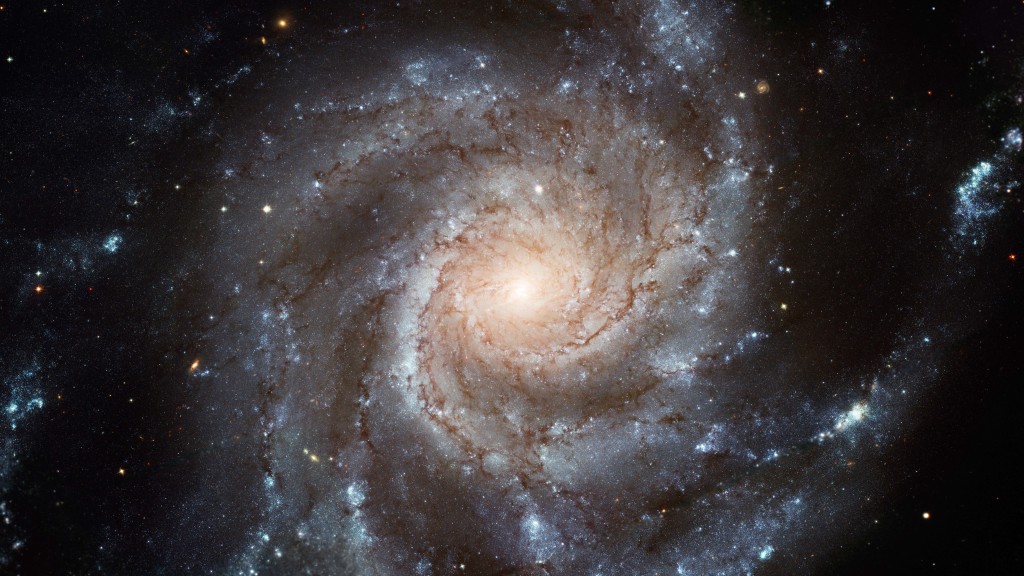

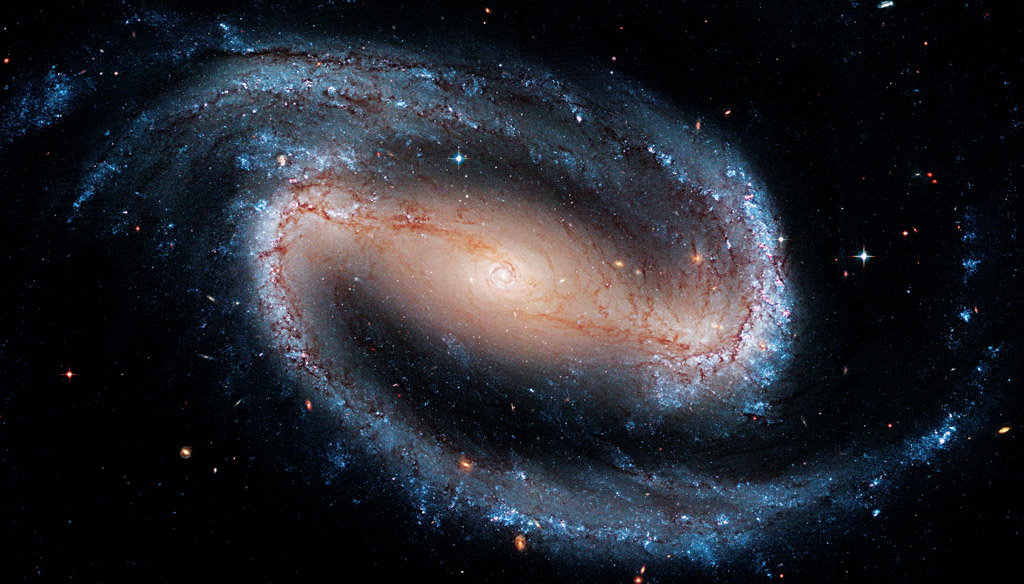

And these…



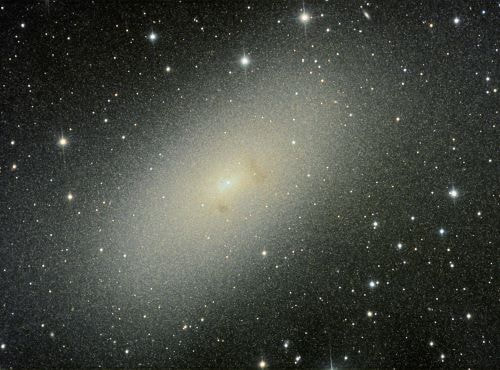
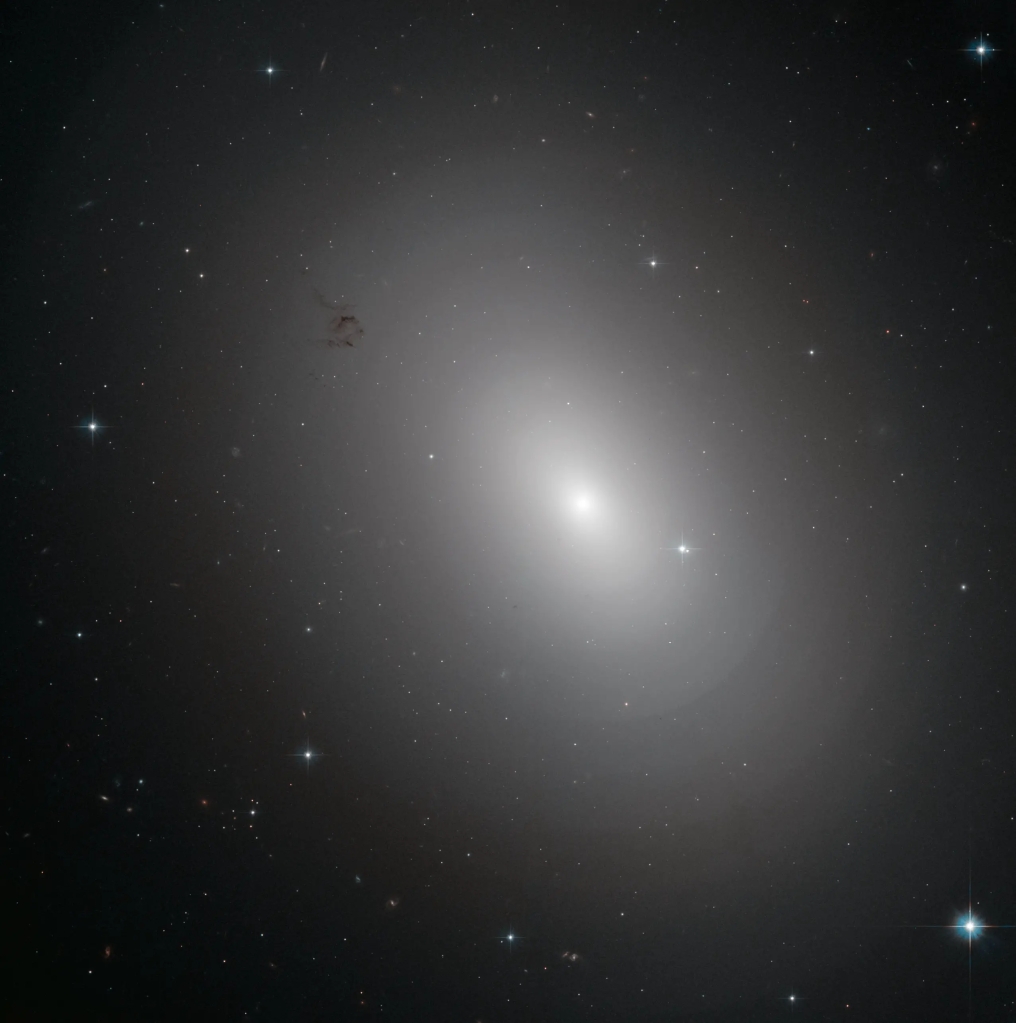
And also these…


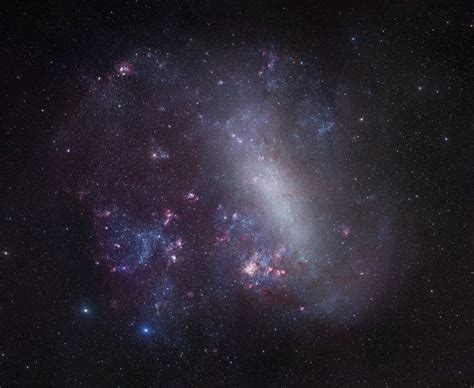

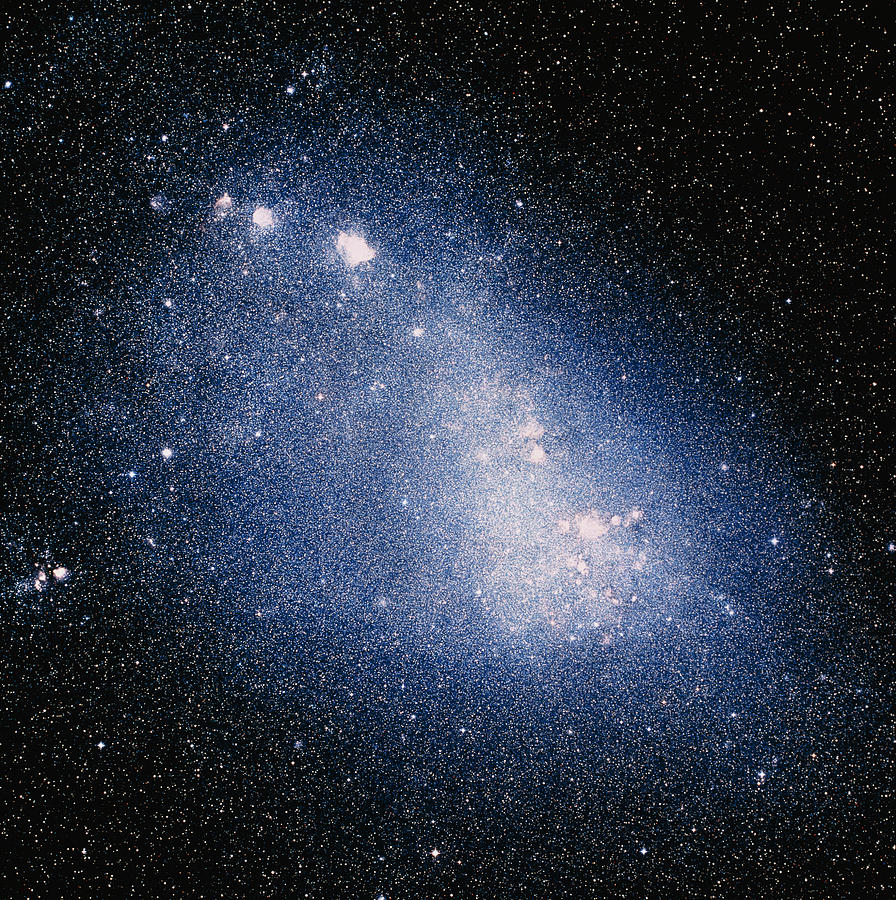
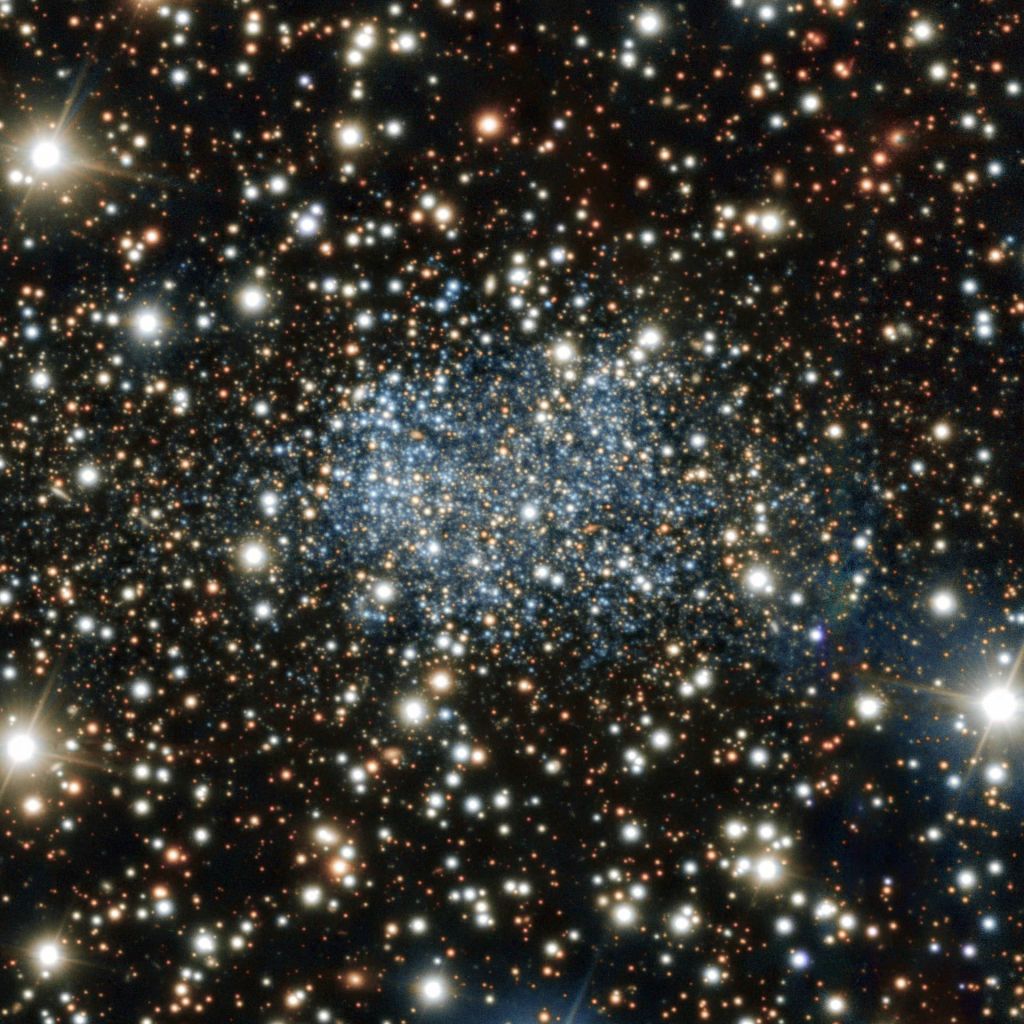
And even these!





These are massive groupings of stars held together by mutual gravitation. Our solar system resides within a galaxy known as the Milky Way, which you can see from our earthly vantage point on a dark night:

The thick band of stars and interstellar dust that arches overhead is the most obvious part of the Milky Way. The stars appear the thickest here because the galaxy is shaped like a disk, and you are looking directly down the plane of the disk.
But everything in the sky that you see at night with your unaided eye–save for our neighboring galaxy, Andromeda–is also within the Milky Way.
There are three main types of galaxies: spiral, elliptical, and irregular.
Spirals

Galaxies like our own and NGC 6814, shown here, are classified as spiral galaxies. They are disk-shaped, like a frisbee, and have spiral “arms” like the blades of a pinwheel. They are made up of all the ingredients necessary to form stars, and are often homes of active star formation.
But all spiral galaxies are not alike. Some are rich in star-forming material (gas and dust) and young, bright stars, but have a small nucleus. Others are poor in gas, dust, and bright stars, but have a larger nucleus.
Still others have a bar-shaped nucleus, rather than a round one. These are called barred spiral galaxies.
Classification

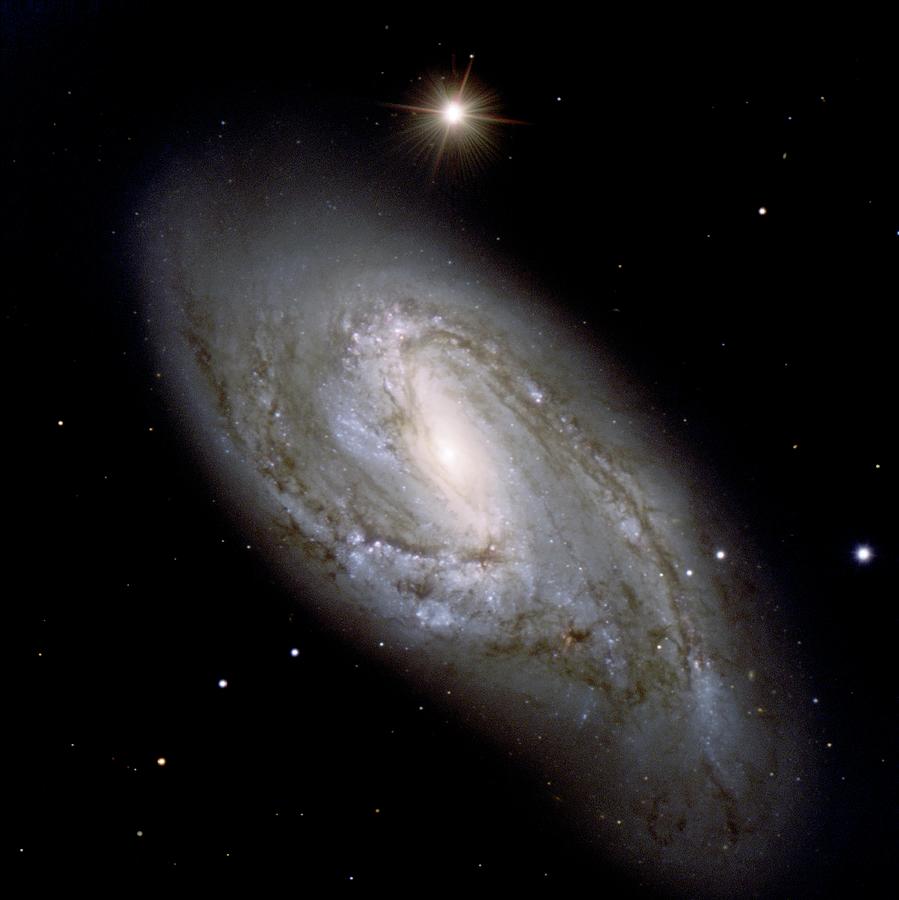
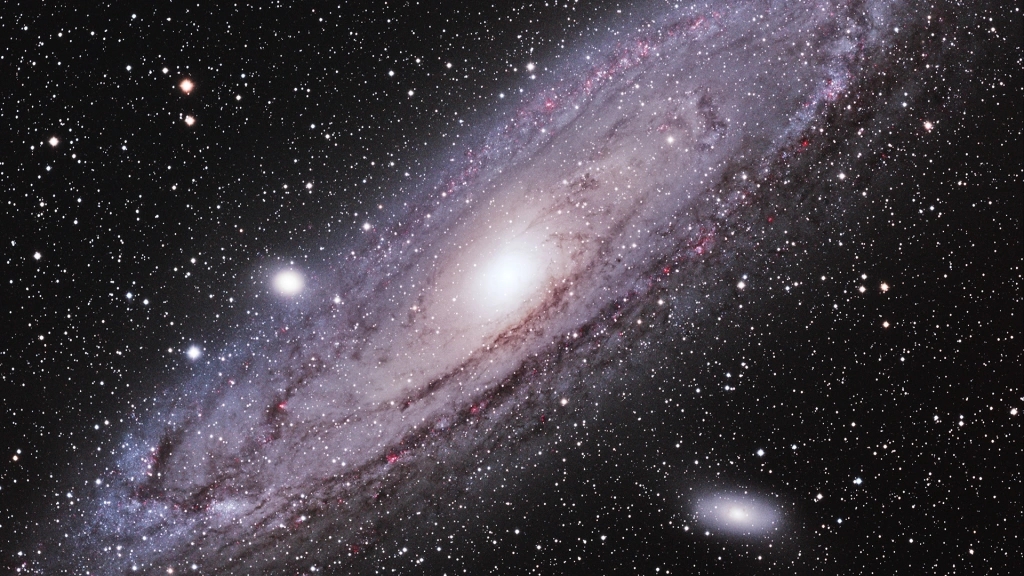


To further classify spiral galaxies, we use a scale of “a” through “c” to describe the size of their nucleus and the presence of star-forming material. A capital “S” indicates that it is a spiral. A capital “B” indicates that it is barred.
NGC 3623, for example, is a class Sa galaxy: it’s a spiral, it has no bar, it’s poor in gas and dust, and it has a large nucleus.
NGC 2997, though, is rich in bright stars and gas and dust, and has a comparatively small nucleus. That earns it the classification Sc.
NGC 3627, our neighbor Andromeda, and NGC 1365 are all somewhere in the middle of these two extremes. They’re classified Sb. But Andromeda and NGC 1365 also have a bar, so their classification becomes SBb.
Spiral subtypes
There are also two “subtypes” of spirals: flocculent spirals and grand-design spirals.
Flocculent spirals have a sort of “fluffy” appearance, like this:

These spirals don’t have a strong two-armed spiral pattern. They are rich in star-forming material, but have little active star formation.
Grand-design spirals, on the other hand, have a quite pronounced two-armed spiral pattern:

Not only are these spirals rich in star-forming material, they’re full of the telltale blue light from young, hot stars.
Then there are elliptical galaxies…
Ellipticals

Elliptical galaxies are round, like a ball. But they can vary in shape quite a bit–sometimes they’re almost perfectly round, sometimes they’re elongated like an American football, and sometimes they can even look squashed, like a hamburger.
These galaxies have almost no gas, dust, or bright stars. They are not home to star formation–they don’t have any of the ingredients.
Classification
They’re classified on a scale from 0 to 7, based on how round they are…


And of course, the “E” designates them as ellipticals.
Last but not least, there are irregular galaxies…
Irregulars
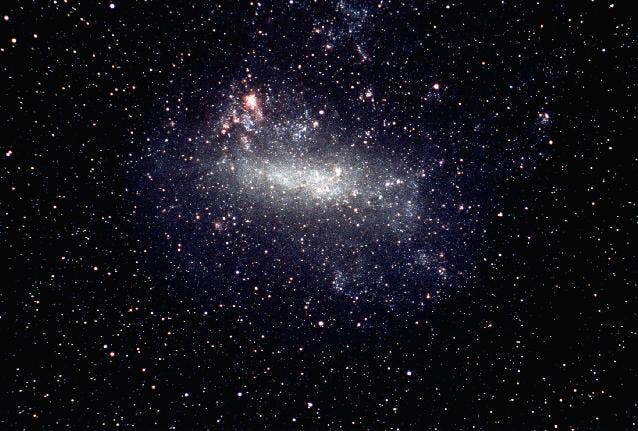
Irregular galaxies have no defined shape, are often quite small compared to other galaxies, and are often home to star formation. The galaxy displayed here is one of the Milky Way’s satellites, the Large Magellanic Cloud.
They are classified “Irr.”
Galaxy clusters
Just as stars are often found in star clusters, galaxies are rarely found alone. They are found within galaxy clusters.
There are two types of galaxy clusters: rich clusters and poor clusters.
Poor clusters

Poor clusters are those like our own Local Group. Often dominated by large spirals, they contain only a few dozen to a few hundred galaxies, spread out sparsely and irregularly.
Rich clusters

Rich clusters, on the other hand, are centrally condensed: that is, the galaxies are crowded more closely together at the center. They are dominated by ellipticals, contain few spirals, and can be home to thousands of galaxies.
The Virgo Cluster, shown here, is the nearest rich galaxy cluster to our home in the cosmos, about 17 megaparsecs (54 million light-years) from the Milky Way.
How were galaxies discovered?
As with all advances in astronomy–with bigger and better telescopes.
In 1845, no one had begun calling the Milky Way a galaxy yet. It was known as the “great star system.” And when William Parsons observed faint “spiral nebulae,” there was no way to tell how big they were or how far away they were–or even whether they were simply clouds of gas and dust inside our own star system.
But in 1924, the new 100-inch telescope at Mt Wilson would change everything.

This was the largest telescope of its time. And Edwin Hubble was able to resolve enough detail on the “spiral nebulae” to settle the debate, once and for all.
Hubble determined that these objects were too far away to be inside our own star system–and both the Milky Way and the spiral nebulae came to be called galaxies.
How far away are they, anyway?
On the order of millions to billions of light-years.
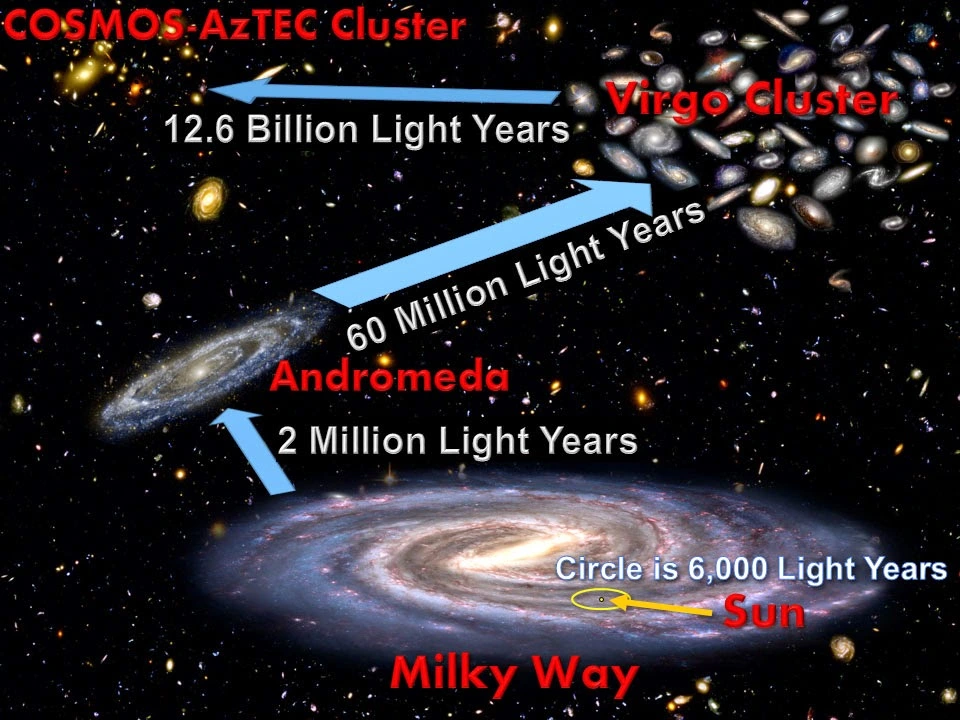
To be clear–a light-year is the distance light travels in one Earth year.
Light does not travel instantaneously–but it does travel ridiculously fast. So if it takes millions to billions of years for light to reach your eyes from a distant galaxy, you can be sure that galaxy is very far away.
But how do we know?
The problem with figuring out how far away anything is in the universe is that brightness doesn’t help. A star or galaxy may appear brighter than others because it’s intrinsically brighter, or because it’s simply closer.

But if we can somehow figure out the intrinsic brightness of a star or other distant object, we can then use how bright it appears in the sky–its apparent magnitude–to calculate its distance.
Hubble determined the distance to galaxies using Cepheids, a type of star that works as a distance indicator.
Cepheids
Cepheids are far beyond the scope of this post, but the gist is that they rhythmically fluctuate in brightness. And we can determine their intrinsic luminosity (brightness) from their period of fluctuation.
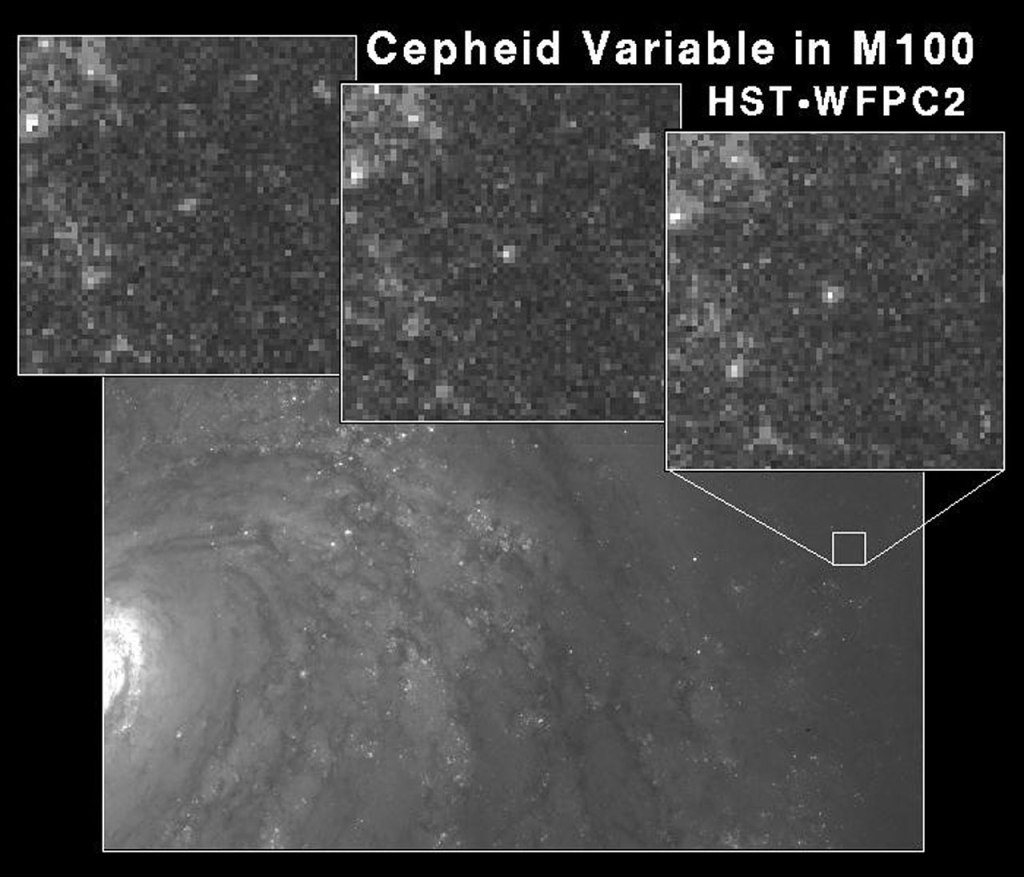
Observing the Andromeda Galaxy, Hubble identified Cepheids and measured their pulsation periods. He was then able to determine their distance–and the distance of their host galaxy.
But Cepheids aren’t the only type of distance indicator.
Globular clusters

Globular clusters are a mysterious type of star cluster. To my knowledge, there’s no single accepted hypothesis for what they are and how they form. But the good news is, they typically have similar intrinsic luminosities. That means they work as a distance indicator.
Cepheids and the brightness of globular clusters are both examples of standard candles: objects that work as distance indicators because the luminosity is known.
But globular clusters also tend to be similar in size. If we measure their angular diameter, we can find their distance that way:

Then we know that their host galaxy is also that far away. In this method, we’re using globular clusters as a distance indicator, but not as a standard candle.
There’s another distance indicator, though, that’s far more reliable than either Cepheids or globular clusters…
Type 1a supernovae

Most of the time, when we refer to supernovae, we mean the death throes of a massive star. But a type of supernova also occurs when matter from a companion star falls onto a white dwarf.
Again, the physics here is beyond the scope of this post. But the gist is that, because a white dwarf is made up of degenerate matter, there is a set limit to how much more mass can get piled on it–the Chandrasekhar limit.
Type 1a supernovae explosions are always similar, and always reach the same peak luminosity. They are the best standard candle we could possibly ask for.
…Except that they’re ridiculously rare, and they’re short-lived events. And in the most distant galaxies, it’s impossible to resolve enough detail to notice one.
So we fall back to…
Galaxies themselves

This method is pretty shaky. After all, every galaxy is unique, and they vary in brightness quite a lot–that’s why we had to use distance indicators in the first place.
But here’s what we can do.
By studying nearby galaxies with visible distance indicators, we’ve found that normal, large spiral galaxies like our own Milky Way are typically about 16 billion times as luminous as the sun.
If we assume that all similarly sized spiral galaxies are similar in intrinsic luminosity to our own, then we can find the brightest spirals in a cluster of galaxies and estimate their distances. Then we average their distances to find a middle-ground estimate.
That leaves a lot of uncertainty.
But there is one very surefire way to estimate the distance to any galaxy–and it doesn’t even rely on distance indicators!
The Hubble Law
The Hubble Law relies on redshift due to the expanding universe. And the key is that light does not travel instantaneously. In a vacuum, it has a set speed–the universal speed limit.

Since the Big Bang 13.8 billion years ago–which we will be exploring very soon–the universe has been expanding.
I’m talking about the literal fabric of space itself.
Imagine that a wave of light is traveling along a road. The wave starts out at a certain length–the wavelength. But as the road itself stretches, lengthening the distance from Point A to Point B, the wave also stretches.
Longer wavelengths appear redder. That’s why we call this redshift.
Because light has a set speed, it can’t reach Earth from a distant galaxy right away. So, by the time the light from distant galaxies reaches Earth, it has had a lot of time to get very redshifted.
Conversely, light from a nearby galaxy hasn’t had time to get redshifted very much.
So, you can estimate the distance to a galaxy just by measuring its redshift.

Alright, back to intrinsic brightness…
How big and bright are they?
It depends on the type of galaxy.
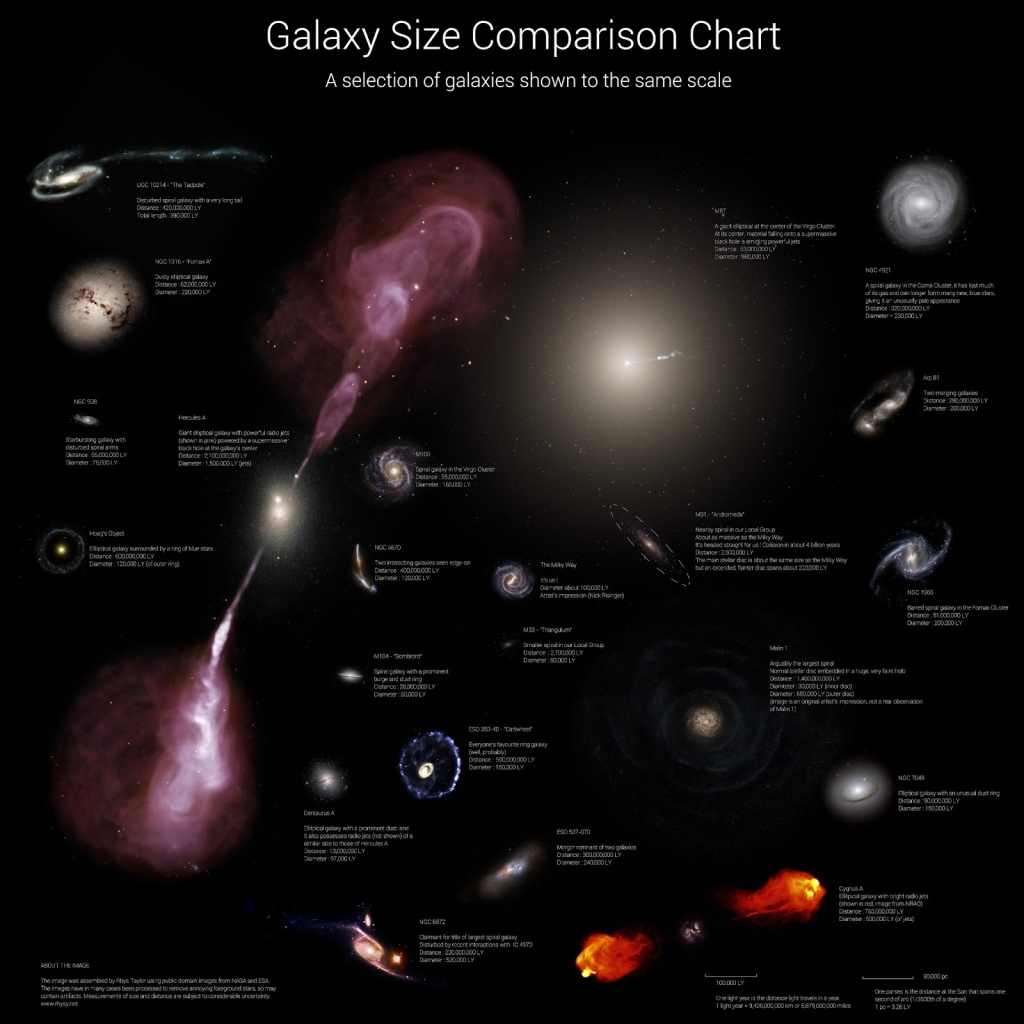
Ellipticals vary quite a lot in size and brightness, ranging from tiny dwarf ellipticals to the ridiculously big giant ellipticals. Giant ellipticals are the biggest and brightest of galaxies.
On the other end of the scale, irregular galaxies are the smallest, ranging between 5% and 25% the size of our own Milky Way. Because surface area correlates directly to luminosity, they’re also the faintest of galaxies.
And then, of course, there are spirals, the most photogenic of galaxies. Most are smaller and fainter than the Milky Way, but there are a few that dwarf our galaxy. The largest known spiral galaxy is nearly 5 times the size and 10 times as luminous as ours!
…but how do we know?
Once we’ve figured out how far away a galaxy is, it’s pretty easy to measure its size and intrinsic brightness. In fact, if we’ve been using distance indicators, we’ll have the brightness bit down already.
If we used the Hubble Law to find the distance, we still need to find the brightness. But it’s still easy.
First, we find their linear diameter:

All this requires is a simple equation.
And then, if we haven’t already done so, we find the luminosity. All we need to calculate it is the distance and the apparent magnitude.
How massive are they?
Massive.

But, again, it depends on the type of galaxy.
Irregulars–the smallest and faintest galaxies–are only around 106 M☉ (solar masses). Spiral galaxies are much more massive, at around 1011 M☉.
Just as in the case of size and luminosity, ellipticals have the greatest range. The smallest, dwarf ellipticals, are comparable in mass to irregulars at 105 to 107 M☉. Giant ellipticals, on the other hand, get up to 1013 M☉.
But, again, how do we know?
There’s no kitchen scale large enough to measure the mass of a whole galaxy. But there are three methods of measuring a galaxy’s mass, and they all depend on gravity.
Rotation curves
Galaxies rotate like frisbees or pinwheels. But that rotation is actually the orbital motion of all their individual stars and interstellar clouds.
We earthlings don’t live long enough to see a galaxy rotate, but we can use the Doppler Effect:
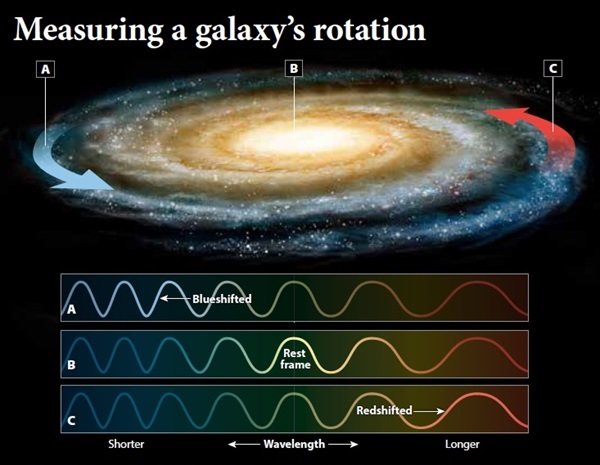
The physics of the Doppler Effect is beyond the scope of this post. But I will add that the redshift here is not the cosmological redshift you saw with the Hubble Law. Cosmological redshift is due to space itself expanding. The Doppler effect is due to the actual motion of objects.
When a galaxy rotates, one side of the galaxy will be rotating toward Earth, and the other side will be rotating away from Earth. We can measure these Doppler shifts and plot a rotation curve:
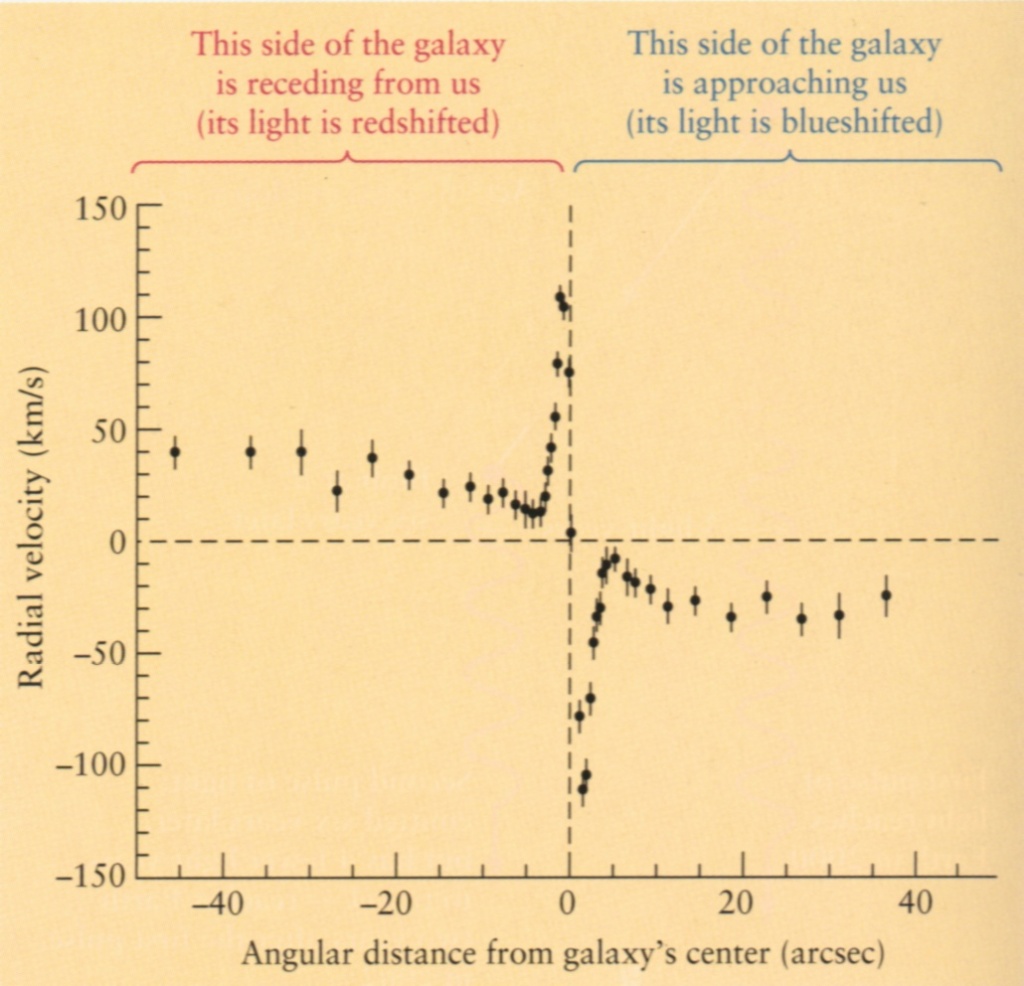
This gives us the velocity of objects at any given distance from the galactic center. From there, we can calculate the period of those orbits, and use Kepler’s third law to find the mass.
Rotation curves are the most accurate way to measure a galaxy’s mass. But for the most distant galaxies, it’s impossible to resolve enough detail to plot one.
So we turn to…
Velocity dispersion
Let’s take a step back from galaxies, and imagine that we’re tracking a single atom in a star’s atmosphere.
As the star rotates, the light this atom reradiates will be redshifted, then blueshifted, then redshifted again–just as you see in this graphic.

But we can’t resolve detail at the atomic level. Instead of seeing a distinct redshift and blueshift, they will be smeared together into one broad spectral line that covers the entire range of the shift:
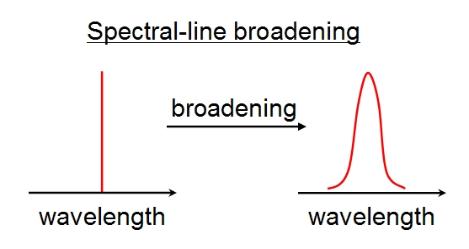
This doesn’t give us a rotation curve, but it does tell us the “maximum” velocity in the galaxy: that is, the velocity of the fastest object.
Then we calculate how massive the galaxy must be so that its escape velocity is greater than its fastest moving object.
Which brings me to…
The cluster method
Because galaxies are most often found in clusters, it’s safe to assume that clusters are stable structures: that is, that they aren’t generally on the verge of flying apart.
So, we can apply a version of the velocity dispersion method: we calculate the speed at which the fastest-moving galaxy orbits the gravitational center of the cluster.
We then ask ourselves, how massive must the cluster be to have an escape velocity greater than its fastest-moving galaxy?
And then we divide that mass by all the cluster’s galaxies to get the average mass of all the galaxies…
Which, of course, is problematic.

Remember that galaxies are a very diverse bunch. Finding the average mass of a galaxy in a cluster doesn’t actually give us the mass of any one galaxy.
As far as I know, that’s a problem astronomers have yet to solve–but the other two methods of finding the mass give us plenty of data. Enough to begin to piece together the stories of galaxies…
How galaxies form and evolve

You know how we’ve been saying that galaxies are found within clusters?
Well, they’re also quite large–a bit like blindfolded elephants blundering around under a circus tent. And they collide quite often.
Collisions
But their stars don’t collide. Compared to the distances between stars, stars are quite small in size. When galaxies collide, they pass through one another, and eventually merge to form one large galaxy.
And that’s how you get an elliptical galaxy.
Seriously–take a look at this timelapse of the predicted collision between the Milky Way and Andromeda.
Notice how they dance around each other, and then merge in the end?
In spiral galaxies, stars’ orbits are ordered neatly within the flat plane of the galaxy. But a collision between two galaxies scrambles those orbits completely out of whack. The galaxy will eventually settle into an elliptical shape.
The collision will also compress interstellar clouds and trigger star formation…
Starburst galaxies

In this close-up of the Antennae Galaxies, we see bright pink emission nebulae and lots of bright blue stars–telltale signs that these galaxies are ablaze with star formation.
Some galaxies take that a step further…
Ultraluminous infrared galaxies (ULIRGs)

These galaxies are shrouded in dust and only visible in the infrared. But they glow a hundred times brighter than our own galaxy. They are the results of mergers between three or more galaxies.
All this rapid star formation uses up spirals’ star-forming material. That’s how we get from a spiral like Messier 101, rich in interstellar dust clouds…

…to a standard elliptical galaxy, devoid of dust and young, hot stars.
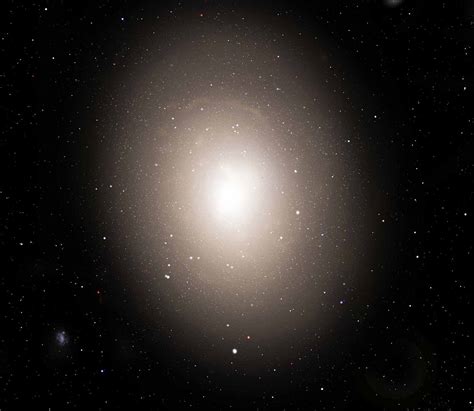
Formation and evolution
Collisions tear spiral galaxies apart. That’s why they’re not common in rich clusters, where the intergalactic environment is crowded and collisions are common. Those clusters are dominated by ellipticals, the results of those collisions and mergers.
But in a poor cluster, spiral galaxies thrive. It’s quite possible that gentle interactions with neighboring galaxies in a poor cluster create spirals’ beautiful pinwheel-like patterns in the first place–and produce the spectacular barred nuclei.
That explains why two large, healthy spirals–the Milky Way and Andromeda–dominate our Local Group.
These gentle interactions can also explain the disparities between flocculent and grand-design spirals. Some spirals do exist in isolation, but they are usually flocculent. Presumably, they need gravitational interaction to produce strong, distinct spiral arms.
But to understand the full story of galactic evolution, we need to go back in time…
The farthest of galaxies
Okay, not really.
There’s no real time travel here. But in astronomy, we are always seeing objects as they appeared at some point in the past, at the time that the light we’re analyzing left that object.
With nearby objects like the moon or the sun, the “look-back” time is only a few minutes. With the farthest visible objects, though, we can peer into a time when the universe was young–the age of galaxy formation.
Observations support what we’ve discovered so far:
- There were more spirals and fewer ellipticals, as expected if ellipticals arise from spirals. In the beginning, most galaxies were still spirals and had yet to merge and become ellipticals.
- The farthest galaxies appear the closest together, supporting the idea that mergers are common. Galaxies are more likely to run into one another if there’s less space between them.
Astronomers have also discovered mysterious blue dwarf galaxies. Their blue tinge indicates rapid star formation.
We’re not sure yet what role they played in galactic evolution, but we know that it’s done. They’re not found at small look-back times. That means they don’t exist in the present day–at least, not in their original form.
And then, there are objects even farther away…

The red smudge you see in this image is a whole galaxy. And it’s not really red; it’s just a redshift. These guys are emitting floods of ultraviolet light from star formation.
They appear red due to the Hubble Law. It’s an enormous redshift. They’re just that ridiculously far away.
And there you have it, people: the stories of galaxies.
I hope I managed to actually simplify things this time–I hope you’ll let me know how I did!
That’s an epic post, Emma!
LikeLiked by 1 person
Lol thanks! I’ve been meaning to come back to it to try to trim it down a bit more…
LikeLiked by 1 person
Hey Ggreybeard, I rewrote this one completely from scratch 🙂 The length was bugging me, and it was leaving even me confused. I think it actually “demystifies” things now! (And it’s about 5000 words shorter.)
LikeLike